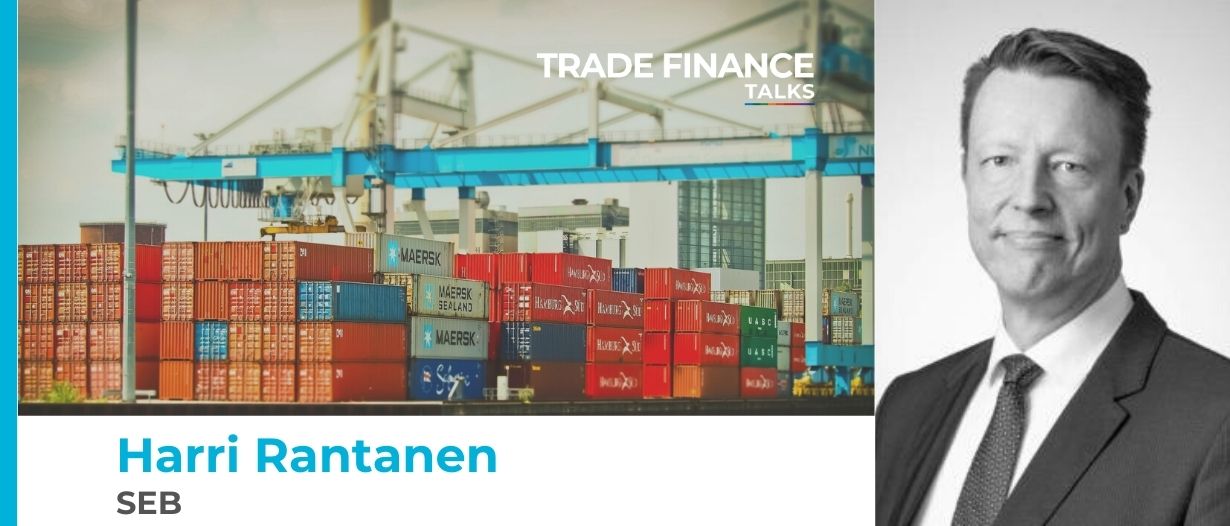“To share or not to share?” A question those in our industry are all too familiar with when it comes to corporate data exchange. in an environment where private individuals are covered by extensive data protection regulation. Business incentives for corporate data sharing are obvious in the new digital platform-based ecosystems, yet technology, methodology, standards, market practices, and rules for it have not so far been able to tackle the corporate doubts to commit to data sharing. The data is already in the corporate enterprise systems, yet is stuck in silos where it cannot be put to use in real time without human intervention and a tonne of manual work. Instead global trade still uses billions of paper documents, which circulate the globe every year.

The experiment
In response to this, we have built a Proof of Concept (PoC) for secure and digitally consensual data sharing around one of the most traditional transaction banking use cases: Export Letters of Credit (LC). Risk mitigation is a centuries old practice, with these financial instruments dating back to the early origins of global trade. They ensure payment from buyer (importer) to seller (exporter) when all the goods or services with their respective business and delivery documentation have been passed over. Banks are involved to cover business, country, and counterparty risks by issuing the LC for the buyer and advising the seller, and taking on the risk. Depending on the business transaction, the LC process can be also very complex, though it remains largely paper-based, and is manually processed by all parties in the Value Network, or Nexus, as we call it.
An LC is a use where the introduction of the tools of secure corporate data exchange would be beneficial. The structured data even has meaning, when it is described in W3C Web Semantics Ontologies, where each data set and its component is available with its usage purpose, giving meaning to the data and ensuring its interoperability with modern information management tools for both humans and machines alike.
The goals of the experiment
In upcoming years, global trade is expected to digitalise so that the various resources in supply chains and ready-made products and services sales will be based on electronic and standardised data sets exchanged securely within the stakeholder ecosystem on various platforms. This will enable each global trade party to choose the most fitting (functionally, geographically, economically) way of trading their goods and services globally. Also, market practice rules, regulations, and jurisdictions will allow the use of digitally exchanged data instead of, or in parallel, with paper documents as legally binding trade attributes. When ecosystem parties will be digitally identified together with the traded goods and services and the data exchange security is ensured with human or system given automated consents, the risks mitigation tools needed now (delivery, financing, and payment) will no longer be relevant. Payments will be automated with the electronic data set triggering smart contracts for delivered goods and services and need for human interruptions being minimised.
In this experiment with the Export LC use case we aimed to show with limited scope of the process at the advising bank, SEB, and exporter, Wärtsilä, how the critical first baby steps are taken in a functional way using existing Sitra IHAN testbed contextual data sharing and consent features with standardised data products provided by Digital Living International and Nixu. With the PoC results we will pave the way for further developments where each of the PoC participants will be able to expand the use case portfolio into their own needs, and digitalise the exchange of information within their value networks.
Achievements
After a successful experiment we were able to promote a technical, functional, and open standard toolset, supported by a template for data exchange, for common use to solve the worst corporate data-sharing pain points. It can be applied to any scope expansion of the trade finance domain, or even on any other corporate structured information data exchange from two to an indefinite number of corporate counterparties or platforms securely, using digitally assigned consent. We were able to showcase with two real-life export LCs between Wärtsilä and SEB that the current paper/PDF document exchange can be replaced by standardised and productised web semantics ontology application programming interfaces (APIs). The APIs enable the use of structured trade finance instruments and processed datasets with clearly and securely assigned access rights from the data owner for the data user alone. No data is stored at the Testbed’s API registration platform but it also acts as the link repository and access right controller for the data access. No copies of the data sets will be left on the platform minimising any misuse capabilities as the data resides in the same system. All the data exchange is done promoting open web standards and the existing TCP/IP-based decentralised architectures.
Dataset descriptions were designed as JavaScript Object Notation (JSON) payloads having also standard semantics descriptions in JSON-LD (Linked Data) to link the datasets to any of the many available trade finance data standards. Expansion to supply chains and logistics increase the challenge of chosen standards and data object artefacts, but the proof of concept enables this expansion of the datasets easily for various global trade domain needs.
Standardised data sets were productised on the data sharing network, based on the initial data modelling work made to extract the generic data from the original paper documents. The advising bank SWIFT instruction data towards the exporter, and the actual presented L/C documents from insurance certificates to forwarder’s cargo receipts, were made available using a component called a productiser. Capable of turning any existing online API into a productised data source on the network, the productisers also make sure that any data provider, such as the exporter, can remain in full control of their specific L/C case data and the individual data products, they choose to share.
The otherwise decentralised network created on the Testbed consisted of the necessary interoperable central component, called a product gateway, capable of providing the data discovery and linking between the data sources and applications on the network. In order to secure the data exchange with a real-world trust, a multi tier digital authentication solution called SisuID was used to enrol and authenticate the people behind the companies. HTML5 based interoperable user interfaces were created both for SEB and Wärtsilä, capable of demonstrating the real time consented data exchange between the APIs, that in the target state would not need any human intervention provided that everything followed the preset rules between the machines.

Moving forward
As the trade finance domain is now pushing a global digital transformation by its stakeholders, the toolset created and tested in this experiment is an open invitation for its use. There will be plenty of opportunities from interested parties to use it in other experimentations. For example, the Digital Trade Standards Initiative (DSI) by International Chamber of Commerce (ICC) could use the toolset to test in practice how the new harmonised standards within trade finance could work. Various new trade finance platforms like Contour, Marco Polo, and we.trade will also need to connect their end-users into the platforms as well to migrate platforms together for extended instrument use cases to meet end user needs. The participants of the PoC are currently considering their own possible use cases for the toolset as commercial Minimum Viable Products. All good use ideas by interested parties are welcome.



























